By Mike Pribesh — Iceland has long been called the land of fire and ice, and appropriately so. But that moniker leaves out a lot. Iceland can also be called the land of wind and rain and waterfalls and sheep. All of those only very slightly begin to describe what this tiny country in the North Atlantic is about. Travel here, by whichever mode you choose, is equal parts challenging and rewarding, with a definite nod to the latter. Biking here can be brutal, and it can be joyous, but at either extreme it is amazing.
Bicycling around the Ring Road has long been very high on my bucket list, and when Iceland opened to tourism after Covid I jumped at the chance. I headed there with my trusty Fuji Cross bike and a lot of warm and waterproof clothes with a well thought out plan of how to tackle the eight hundred plus miles of what is essentially the only road to circle the country. I say essentially. It is the only road to actually go around the whole of Iceland, with offshoots along the way either to the empty center or to the coast on the rare occasions the road moves inland. Many of those offshoots inland rapidly turn to dirt, and then rougher dirt, and then crushed lava dirt and rocks, and then… well, you get the gist. The vast majority of Icelandic civilization is concentrated on or very near the coast, so it is wise not to venture too far into the hinterlands unless you are very self-sufficient.
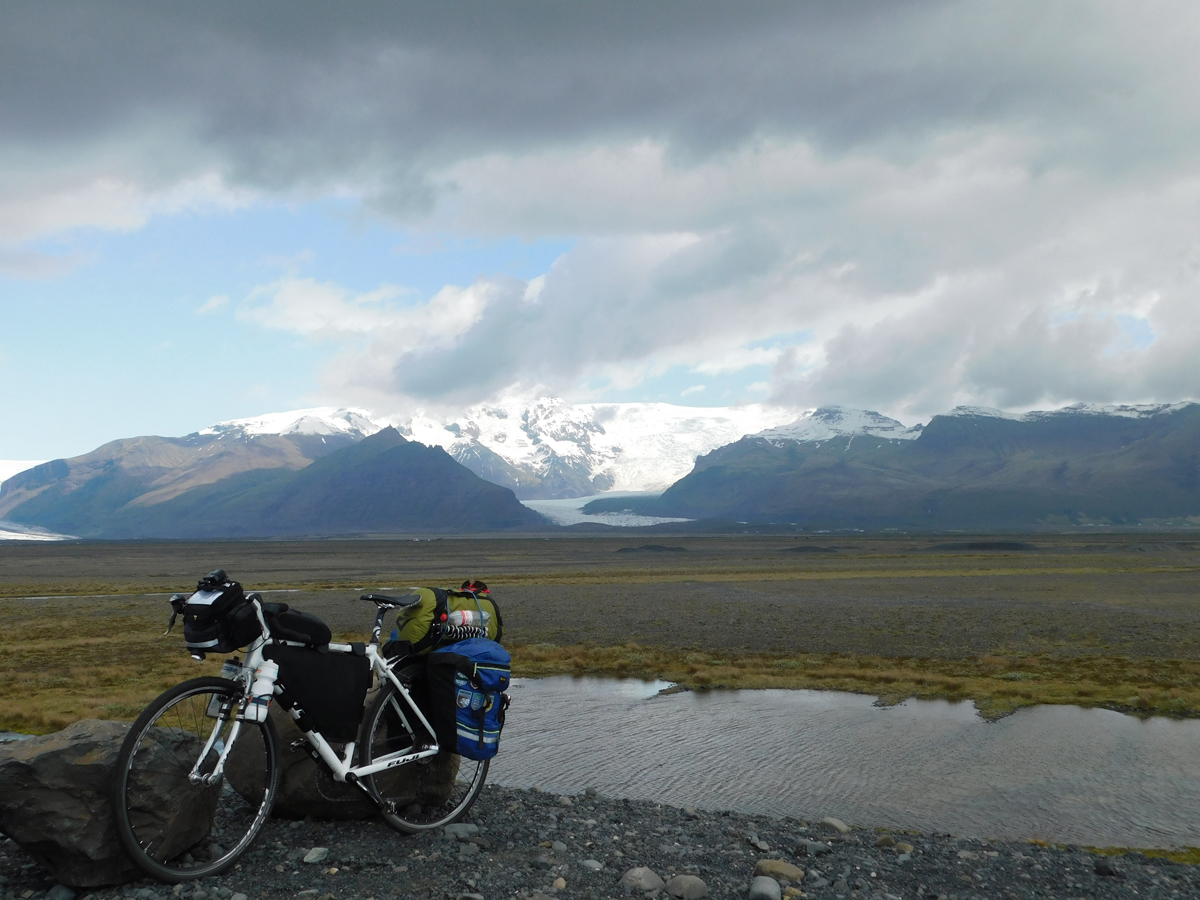
After probably too much research on weather and wind patterns, I chose to tackle the trip counter- clockwise. Not that this provided an advantage though. Icelandic winds are equal opportunity and blow wherever and whenever they choose, forecasts or patterns be damned. From my exhaustive research, I determined the probability of favorable winds on any given day was about fifty percent, which meant the probability of unfavorable winds was about, well, fifty percent. I chose my direction based on there is more to see on the southern coast than the northern stretch, and I wanted to be fresher for side jaunts and sightseeing.
Keflavik Airport is an outstanding starting point, and it even has a dedicated bike assembly spot in a converted Conex trailer with a windowed front and several repair stands and tool setups. This is the only airport I have ever seen this, and it definitely beats tucking into an out of the way corner of a terminal to assemble your bike and belongings after a long flight. Leaving is simple and safe, unlike so many airports around the world that clearly didn’t think of bicycles even as an afterthought, and not even once did I think I was about to die.
Long trans-Atlantic flights do nothing positive for your body, and a dip in a hot spring would do wonders for recovery. As luck and geography would have it, the famous Blue Lagoon is only about fifteen miles from Keflavik, and I made a beeline there as fast as my tired legs would take me, reservation already in hand. My reservation, made months before, wasn’t really necessary after all, as there were maybe two dozen people in the lagoon, which is huge. If you want to avoid crowds, I highly recommend travelling immediately at the end of a pandemic. The Blue Lagoon is normally very crowded, and rightfully so. It’s incredible. The warm, opaque, milky blue water surrounded by ancient lava flows, silica mud mask, and a swim up bar make for a very enjoyable and relaxing experience. It’s a highly unmotivating experience because I didn’t want to leave, but I forced myself after a couple of hours because I still had forty-ish miles to ride to my planned destination for the night.
My route along the southern coast took me through stunning scenery, so much so that I had a hard time keeping an eye on the roadway. To the right were usually pastures and beyond those the ocean, and to the left were amazingly green hills with waterfalls galore. In the pastures, and on the side of the road, and in the road, and in the hills, were sheep. So many sheep. And they are very loud sheep, bleating as I passed them by and at night as I camped. They came to be rather soothing in the evenings while I was in my tent.
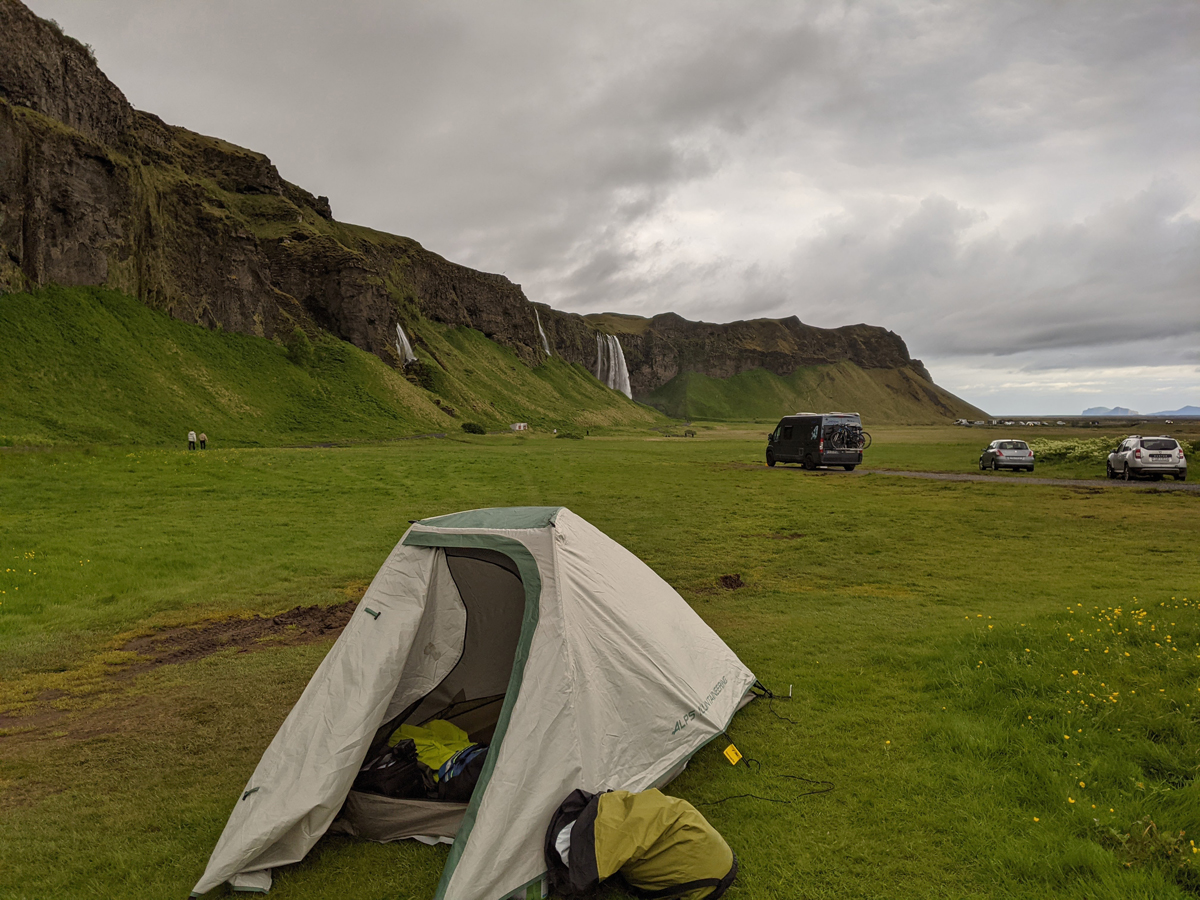
Iceland is known for its waterfalls with some of the most famous of them right along my route. And they are epic. I’ve always had an affinity for waterfalls and tend to plan hikes and rides just to see them, so I was happy as a freshwater clam as I rode past them. There are numerous unnamed (as far as I know) cascades tumbling from the cliffsides to provide a short-term waterfall fix between the major ones. My second night camping was at the base of Gljufrabui and a couple of hundred yards from Seljalandsfoss. Yes, the big ones are all named, and good luck pronouncing them. Seljalandsfoss even has a hollow in the rock so you can walk behind the waterfall. Bring rain gear.
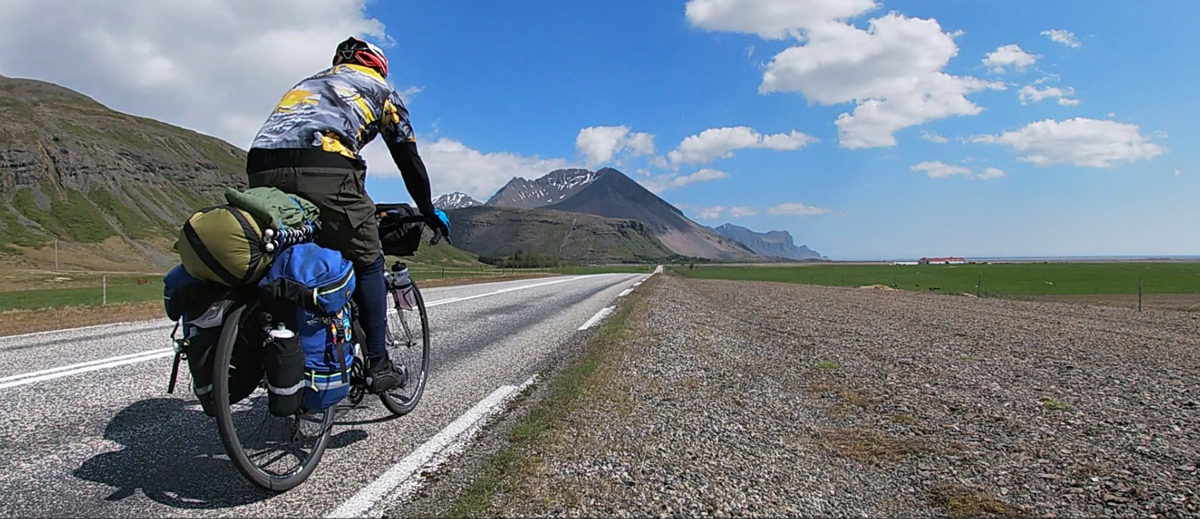
As I mentioned, I wanted to ride the southern coast while I was fresh so I could make side trips off the main road, and my plan worked well. A five-mile detour down a very steep hill to Reynisfjara Beach was well worth it even though it meant riding back up that same very steep hill. The black sand beach with striking rock formations is not to be missed, just watch out for the sneaker waves that might try to sweep you out to sea. The mile or so off shoot to the Selfoss waterfall was also a must do, and the restaurant near the parking area had a frosty cold beer for me too. Sometimes I get a little lazy on these trips and don’t want to do the extra miles off my main route, but I am happy I did. Every single side jaunt I took was worth it.
At the beginning I said Iceland could also be known as the land of wind and rain, and I say this from experience. In the first week of the ride, I had tailwinds, headwinds, crosswinds, and even no winds. I also had torrential rain, gentle rain, drizzle, clouds, and even brilliant sunshine. The no wind and brilliant sunshine were rare, but their occasional appearances were most welcome. Traveling in a country this far north and in the middle of a very cold ocean creates some challenges, but it wasn’t as tough as some of the horror stories I’d heard.
Continuing eastward, I passed through vast barren flats of glacial runoff between Kirkjubaejarklaustur and Svinafell and to the glacial lagoon of Jokulsarlon and Diamond Beach, where the broken bits of glacier ice wash up on the black lava sands and glitter like jewels on sunny days. The fjords of the southeast and beautiful coastal fishing villages like Djupivigor and Faskrudsfjordur were both stunningly beautiful and frustratingly challenging. (Town names included mainly for the entertainment of you trying to pronounce them correctly. You will fail.) One particular stretch involved riding up and down four fjords in one day with a thirty mile per hour headwind on the inland sides with a roller coaster of fifteen percent grades, all with a backdrop of tall snow-capped mountains on one side and blue ocean on the other. At one point I stood at an intersection of the Ring Road and side dirt road I had been told about, contemplating the option of shortening this section of the ride by a full day. Two hard days of following the coast up and down numerous more fjords, or one brutal day over a mountain pass on a dirt road in the rain and with a seemingly hurricane force headwind. I elected the former and it made the right choice, because that’s the day I saw my first wild reindeer.
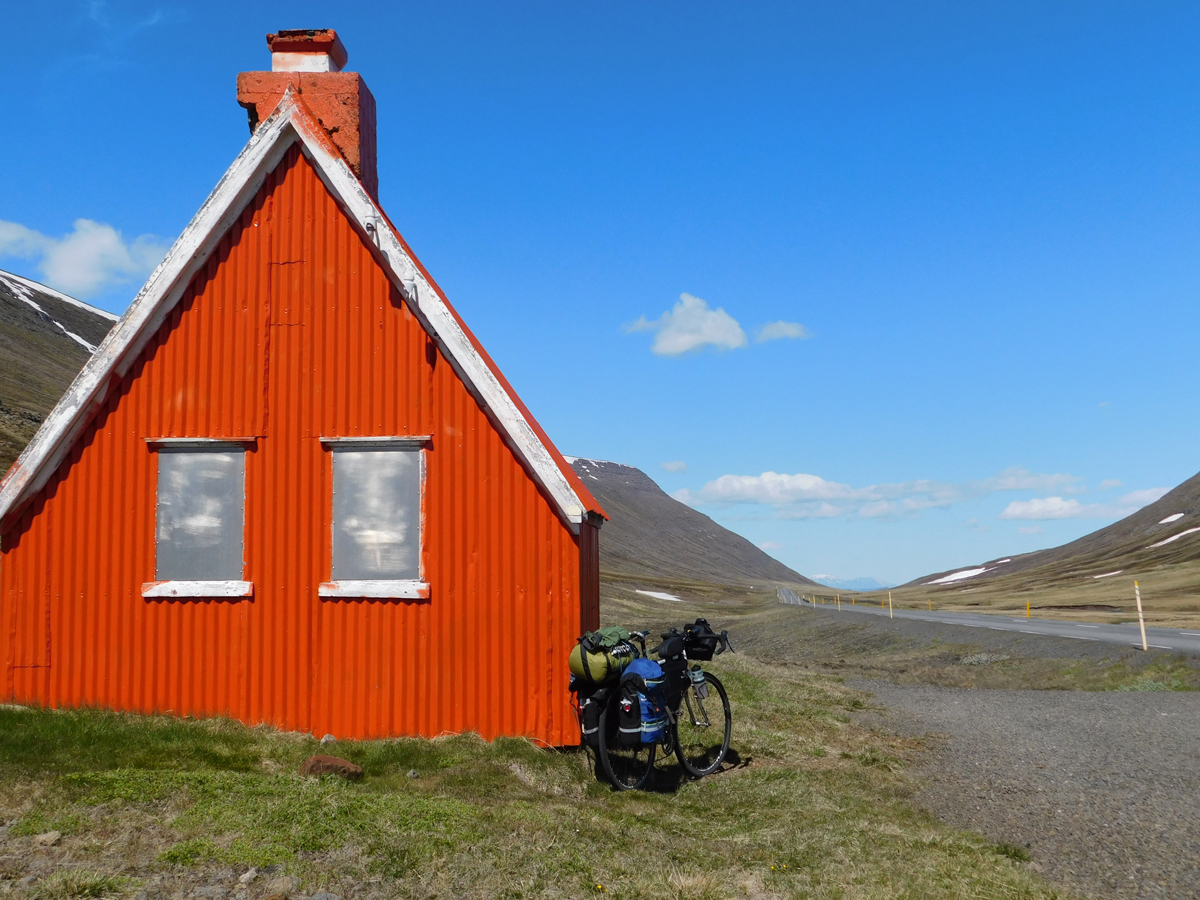
I had some decisions to make upon reaching Egilstdattir, which was the far eastern point of my route. The weather forecast was looking bleak for the next few days, and I would be riding into some heavy winds across some of the most barren areas of the entire country. I decided to fast forward a little and hopped a bus to Lake Myvatn and saved myself two or three days of soul sucking headwinds. It was a wise choice. Camping at Myvatn, I had to pitch my tent close to two others in the shelter of an outbuilding to avoid being blown away by the seventy plus mile per hour gusts. On the plus side, Myvatn means mosquito, and those little buggers didn’t stand a chance in those winds.
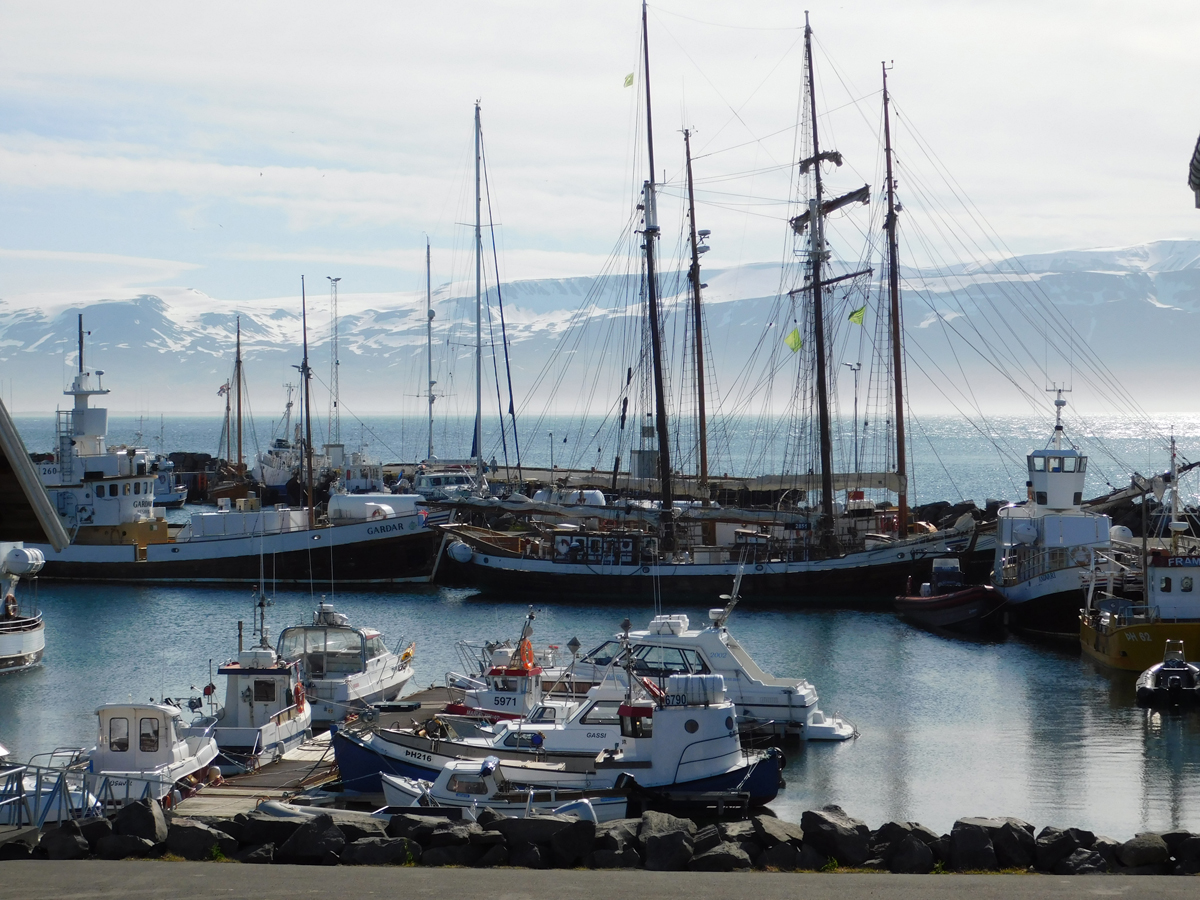
I felt a little down on myself for taking the bus as I pride myself of trying to ride every inch of whatever trip I’m on, and I did some serious reflection lying in my tent that night, partly wishing I had ridden instead of bused, partly rationalizing that it was the wiser choice, and partly wishing I was at home in my cozy bed. The rationalization won out, and to make up for my self-perceived cheating, I rode north to the town of Husavik, which turned out to be the highlight of the entire trip.
Picture in your mind the iconic fishing village, with boats at the docks in the harbor and quaint houses and buildings on the shore. Now add to that snow covered mountains on the other side of the water with the evening sun glistening on both. Add to that a community fair on the waterfront with live music and beer and probably the best fish and chips I’ve ever had. And top that off with the best weather of the entire trip. Bliss. Any down thoughts I had been having floated away and all was right with the world.
I found the people of Iceland to be very friendly once you broke the ice. Mostly they would not start a conversation, but were happy to talk once I asked questions, and were very helpful and kind. A perfect example of this was the couple I met at the entrance to the Vadlaheidargong tunnel. There are two tunnels in Iceland in which bicycles are prohibited. This was one of them. I was faced with yet another dilemma, find a way through to Akureyri, my destination for the night, or ride an additional twenty miles over a three-thousand-foot pass on a dirt road. As I pondered my situation, a car towing a trailer with two mountain bikes turned toward the tunnel and I flagged them down. Long story short, they gave a stinky stranger and his bike a ride through the tunnel and saved me several hours of climbing and cursing.
Mechanical issues with the bike (three broken rear spokes) changed the trip from there. Bike shops are very few and far between, and being the idiot that I sometimes am I didn’t have any spare spokes, so I was back on a bus to Reykjavik. Once there, I scrambled to find a bike shop before they all closed for the evening. Reykjavik has an amazing path system with one for bikes paralleling one for runners and walkers. It was a very enjoyable ride until a bunch of jerk runners started yelling at me and giving me dirty looks. What happened to the friendly helpful Icelanders? Then I realized that I had wandered on to the runner’s path, and I was the jerk. Oops. I quickly scooted off into a neighborhood and proceeded to get very lost. I wandered to and fro for a while, trying to keep mainly in the same direction I had been heading, wondering how I was going to figure this one out. My maps didn’t work on my phone, and I naturally didn’t have a paper map (again, idiot), so I was going by sheer instinct, and lo and behold, I popped out right at the shop I had been seeking, the Bike Cave. Genius or sheer luck? Probably the latter.
The Bike Cave turned out to be so much more than a shop. It was also a café, and the owner is a Warmshowers host, so I got fed, bike fixed, and a warm bed for the night, plus a ton of advice, over several adult beverages with the owner’s husband, about where to go next. That advice led me to make yet another change to my plans.
There is a tremendous amount to see in what is called the Golden Circle, an area to the east of Reykjavik. Geysers (including the original geyser, where the word actually came from), massive waterfalls, more hot springs, a thermal river, and believe it or not, tomato and banana farms. I knew I would only have time to see a very few of these if I continued by bike, and since it will probably be a bit before I get an opportunity to return to Iceland, I decided to make the most of my remaining time and rented what might be the world’s smallest car – a Toyota Ayko. I shoehorned the bike and all my bags into what Toyota ambitiously calls a back seat and carried on.
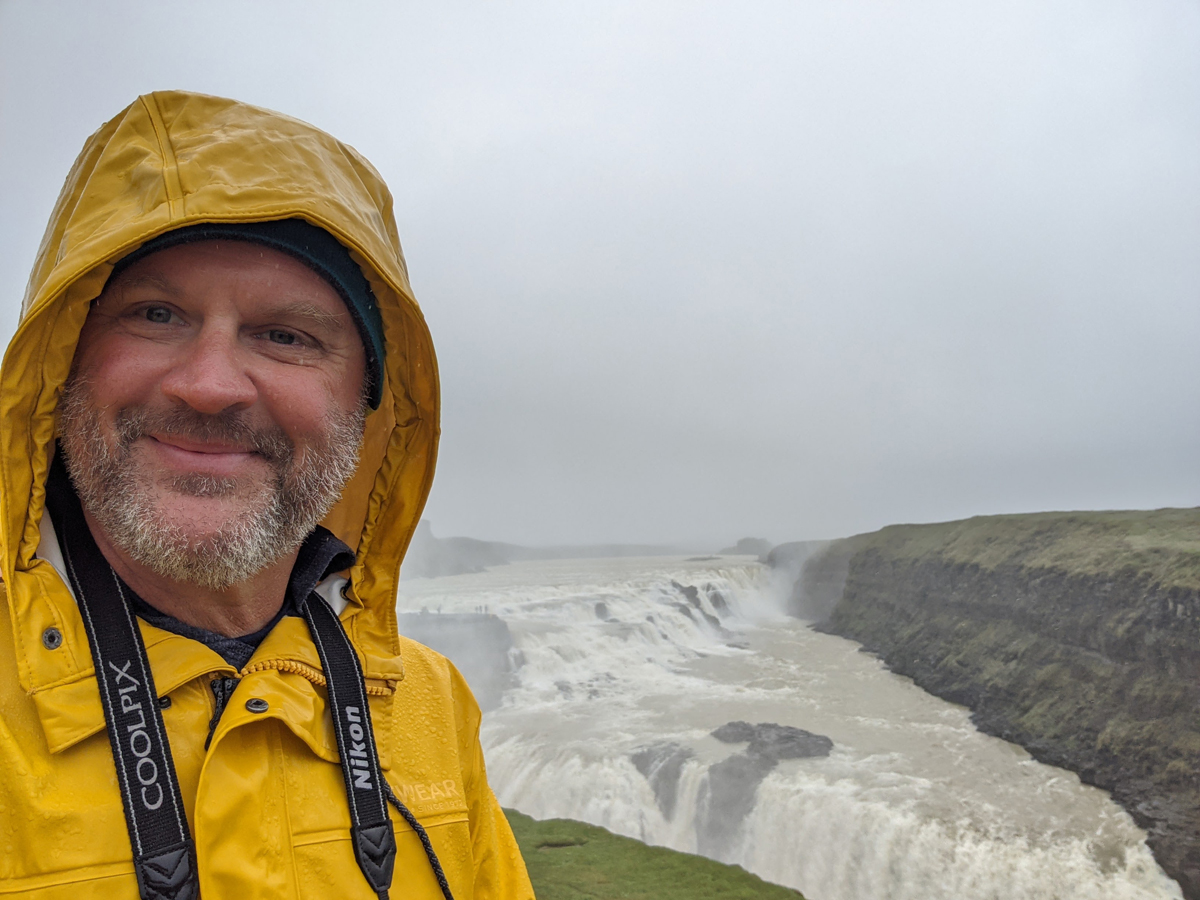
The Golden Circle is a continuation of the amazing scenery I had passed on my entire ride. Gulfoss waterfall is enormous and spectacular. The hike to the thermal river is strenuous, but once at the top a small stream of hot water runs through the hillside with small pools to soak in. While there I saw a fellow bike tourer from Italy who I first met on one of the fjords on the complete other end of the country. One of my favorite stops of the whole trip was the Secret Lagoon, a smaller, lower key version of the Blue Lagoon. I even straddled the junction of the North American and European tectonic plates at Thingvellir National Park, so I was essentially standing on two continents at once. I even hiked to the actively erupting volcano, although it was not very actively erupting on that day. I guess even volcanos need a day off from time to time.
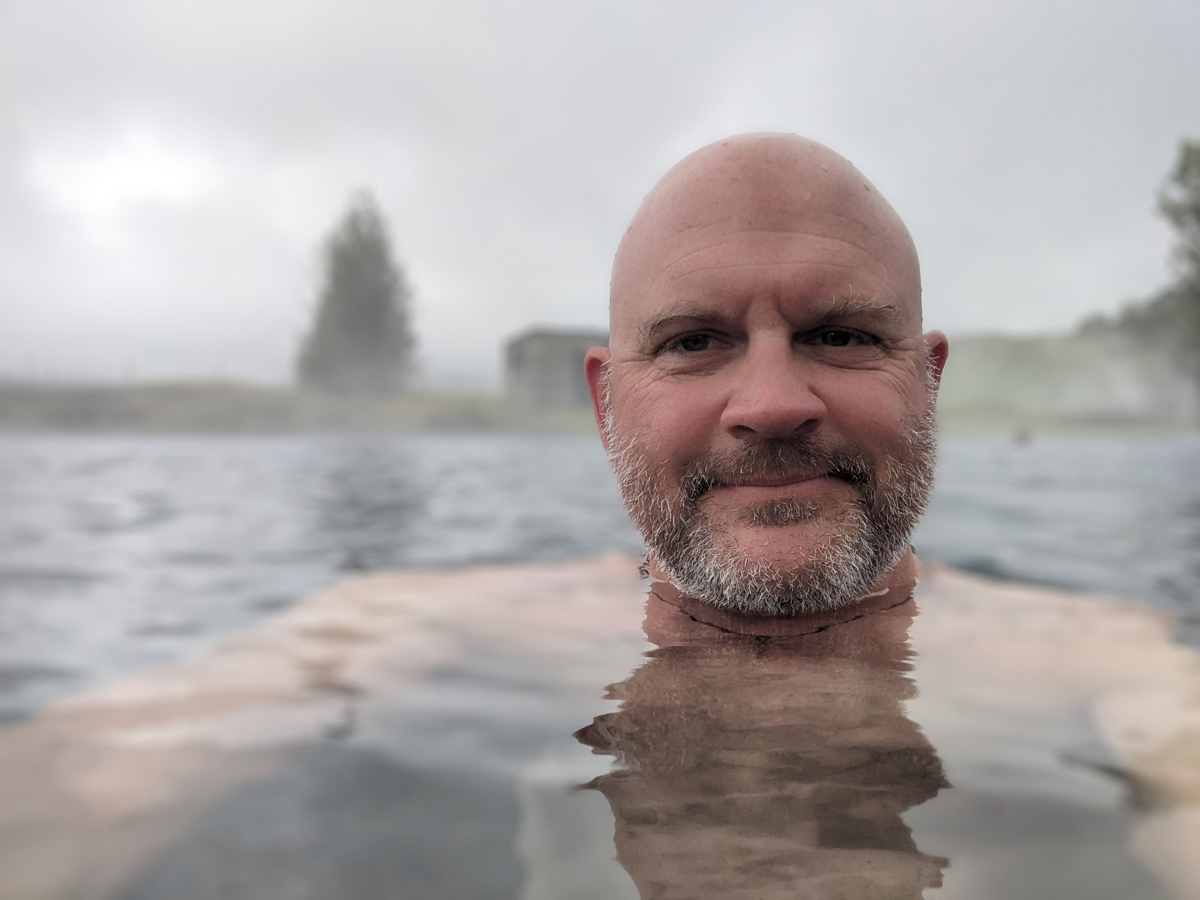
Returning to the airport and realizing my trip was complete was bittersweet. I was ready to go home, but also didn’t want to. I spent a fair amount of time on the flight home thinking about the trip as a whole and thinking about how to do it again. There’s still the Westfjords area in the Northwest, the whole interior of the country which is lightly crisscrossed with barely rideable roads, trails, and rivers. And puffins. If nothing else, I’ll return to see the puffins that eluded me this time.
Ride Details:
- Start and end location: Keflavik Airport- Southeast of Reykjavik
- Total ride miles: 608
- Total ride days: 12
If you go:
- Navigation is easy. The Ring Road is the only main road. If you stay on it, you can’t get lost, and it will eventually bring you back to where you started. It is a big ring after all.
- Prepare for the weather. It is windy. It is rainy. It is windy and rainy. Invest in quality rain gear and warm but breathable cycling clothes. I found I was almost always one layer away from just right. The raincoat I brought was sub-par so in Vik I bought a new one that was overkill but completely waterproof for an ungodly amount of money. Which brings me to the next point-
- Iceland is expensive. Food and drink in a restaurant ran about $30 for just me no matter where I was. Restocking supplies for on the road was cheaper, but not by a lot.
- Wild camping is technically illegal, but there are tons of reasonably priced campgrounds. In fact, camping in small, converted minivans seems to be the national pastime. I never had trouble finding a campground, and they are all basically big fields so you can pitch a tent pretty much anywhere.
- Cash is a waste of time. I used coins for a shower once, and that was the extent of my cash use. Even at campgrounds the attendant would come around with a card reader. Don’t be shocked when she tells you it’s 15,000 Krona. That’s about twelve bucks.
- Don’t worry about a language barrier. Everyone speaks English. It is taught in schools starting at age five. Some of the older people I met were less versed, but many of the younger ones speak English with virtually no discernable accent. If you try to speak Icelandic to a native based on words you are reading, you will sound like an idiot. Don’t ask me how I know this.
- If you go to Iceland in the summer, it does not get dark. Ever. If you are camping, bring a sleep mask. It’s seriously bright even at two a.m. And if you hope to see the Northern Lights, go in the winter. You will not see them in the summer.
- I’ve made a two-part video of this adventure. You can view them at:
- Part 1: https://www.youtube.com/watch?v=uSQjCdpTFnE&t=34s
- Part 2: https://www.youtube.com/watch?v=VgtP71ANwOo&t=1248s


Thank you for this awesome trip narrative – really appreciate the weather/wind information – can’t wait to do at least part of this ride someday!!!
Thank you for your report. May I inquire about bike bag storage at the airport? Also, rather than full-on bike camping with all your gear were there enough alternative lodging options such as hostels and B&Bs along the route to still make the trip, perhaps with a small backpack for weather gear and clothing? Could a road bike with 28mm tubeless street tires handle the trip?
And also, I assume with your mention of numerous bike shops on the island that bike rentals would be available also?
Thank you,
George Croft